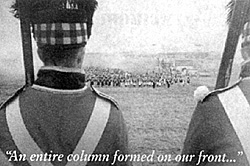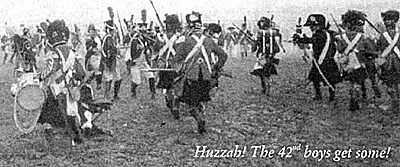 The day of the battle dawned overcast and humid, it had
rained heavily the night before, we remembered the sight of
Kings German Legion (KGL) and the Rifle Brigade,
camping under the hedgerows the day before. We wondered
how they had fared overnight. This weather was exactly the
same in 1815 and the troops were almost as wet. The entire
battlefield was a quagmire, at times we were in danger of
losing our shoes and boots in the sticky grey mess. The
Australian contingent promptly decided that if any of us
were called on to "die" during the battle, we would make a
miraculous recovery prior to falling over. We did notice that
this thought pervaded the battlefield with very few casualties appearing on either side.
The day of the battle dawned overcast and humid, it had
rained heavily the night before, we remembered the sight of
Kings German Legion (KGL) and the Rifle Brigade,
camping under the hedgerows the day before. We wondered
how they had fared overnight. This weather was exactly the
same in 1815 and the troops were almost as wet. The entire
battlefield was a quagmire, at times we were in danger of
losing our shoes and boots in the sticky grey mess. The
Australian contingent promptly decided that if any of us
were called on to "die" during the battle, we would make a
miraculous recovery prior to falling over. We did notice that
this thought pervaded the battlefield with very few casualties appearing on either side.
Because of the crowd, we debussed about a kilometre from the battle site and quick marched to the form up area. The British and Allied line stretched for approximately a kilometre. The German Engineers had constructed a model of La Haye Sainte directly to our front, this was manned by the KGL and defended by the 95th & 60th Rifles. To our left were the Belgium and the Dutch Brigades. Directly on our left flank was a three gun half battery of Dutch artillery. On the extreme right flank were the Royal Artillery with another three gun half battery. Directly in front of us, about 1.5 kilometres away the French were forming up. There was continuous sporadic gunfire coming from the French lines.
The fire control by their NCO's and Officers appeared very poor or more accurately non existent. Nothing was heard from the allied line until the order to fire was given. Our cavalry were sending out patrols, probing the French lines.
The Highland Brigade which we were a part of, practised forming square and moving in brigade strength. The French continued to form up in front of us. It appeared they outnumbered us two to one. I counted eight French artillery pieces directly to our front.
The combatants on the English and allied side were made up of three Brigades. The Highland brigade which we were part of consisted of the 93rd, 71st, 42nd Regiments, with "soldiers" from New Zealand, Canada, USA, Germany, United Kingdom and Australia. The other Regiments attending were the 2nd Queens, 64th Durhams, the 1st Foot Guards, The United Militia of upper Canada, the 95th and 60th Regiments, the Royal artillery, cavalry and a large contingient from Germany representing the King's Ger man Legion. There were other British units in attendance and I give my apologies in advance if I have not mentioned them in this article, as the battlefield was vast and we only had a limited view from our position.
The Prussian army were made up of Landweher and other Prussian units that tend to be a mystery to me. The French army was made up from Francophiles from all over the world. After the battle I met several French infantryman from Russia and the Ukraine, one of who turned out to be a Lieutenant in the KGB. One of the largest French units in attendance was the 21éme of whom the majority of its members are English.
The assembly took some three hours, at 1100 hours the French Artillery opened up with a thunderous cannonade. Even at the range we were from the guns, we could feel the concussion and see the muzzle blast. The battle progressed with a series of feints along the line, until a French column advanced on the farmhouse of Hugoumont on our right front. We watched the battle ebb and flow around the farm compound, until an English Light Infantry Regiment reinforced the beleaguered defenders of the farmhouse.
At this point a French column began its advance against La Haye Sainte directly to our front. The 95th Rifles and 71st Light Infantry harried the column with sporadic fire until they clashed with the KGL who were defending the farmhouse. The Highland Brigade were ordered forward to support the KGL and the 71st.
 We advanced, pipes skirling, colours flying, the adrenalin pumping. The French column
divided as we approached and began to outflank us. The
42nd Royal Highland Brigade fired several volleys, those
that could anyway. We still had the non firing dummy
muskets. The French cavalry came out to menace us. The
Brigade commander ordered us to withdraw in square, back
up the flanks of Mount St Jean. The French column again
attacked La Haye Sainte.
We advanced, pipes skirling, colours flying, the adrenalin pumping. The French column
divided as we approached and began to outflank us. The
42nd Royal Highland Brigade fired several volleys, those
that could anyway. We still had the non firing dummy
muskets. The French cavalry came out to menace us. The
Brigade commander ordered us to withdraw in square, back
up the flanks of Mount St Jean. The French column again
attacked La Haye Sainte.
Atmosphere
I cannot adequately describe the atmosphere of this enormous re-enactment. With the amount of noise, colour, men cheering and swirling gun smoke, I would describe the experience as the closest thing to "being there" that I have ever encountered or dreamed of. The crowds disappeared into the background, all around us were lines of uniformed men, screaming and yelling like madmen as they discharged their muskets. The scene is truly indescribable. Speaking to my comrades after the battle was sobering. They described scenes that had happened around us that I was completely unaware of, because I was so involved in my own scene, or I had been distracted. My partner who stood in the centre of the column with the other women, saw things that I had missed. I must say the other fellows in the English 42nd Regiment were superb. Several of them gave us their muskets and ammunition to fire as they didn't want us to travel home without firing a shot.
The French cavalry had massed on our left front and began to advance in strength on the British and Allied line. All units immediately formed square to meet this threat. I still vividly remember a French cavalryman leaning down out of his saddle, trying to part my feather bonnet with his sabre. I still have the scars on my bayonet where I parried him away. The atmosphere was affecting all the other re-enactors. The cavalry charges went on for some time before they finally withdrew to their lines.
We heard the 'pas de charge' being drummed out before we saw them. An entire column had formed on our front and were advancing up the hill towards us. We were ordered to fix bayonets and load. I now understand why the column was a formidable French tactic. As they advanced, calling 'Vive L'Empreur!' and playing their massed drums, the sight was magnificent. At 40 metres we opened fire, pouring continuous volleys into the column. They vanished in a cloud of smoke, their position given away by the dull red flash of their muskets aimed at us. The shout went up "they're withdrawing!" We were given the order to advance and roll them up with the bayonet.
The whole British and Allied Line advanced down the hill, the French firing continuously as they withdrew, no one knew where we were as we marched into the gun smoke. The final battle took place down at the edge of the French line. I have an image of a French infantryman coming out of the blinding smoke carrying his musket at high port. He meant business. I remember clashing with him, musket to musket and pushing him into the mud under foot as we advanced. Too soon it was over
The French marched away first (of course), leaving us to pick our way through the fields of tall and f lattened wheat and rye as the roads were clogged with masses of tourists heading home. We finally reached the car park, where we waited patiently for our transport. Word quickly went around that the French units had bussed back to the village and our Officers wanted us to march back. Quickly all signs of weariness vanished as the British column formed up. Anything to show the French up. It was approximately a four kilometres march back to the village, I think if it had been ten, we still would have made the march. The "esprit de corps" would have carried us anywhere.
Back at Waterloo we all formed up in the town square, various dignitaries made their speeches after which we were stood down for the afternoon. There are several good museums in the vicinity of the battlefield with numerous monuments to the various Regiments and Commanding Officers. We were rather surprised at the monuments around the village itself. There were very few references to the British or Allied participation in the Battle of Waterloo at all. If you were visiting with no knowledge of the outcome, you could be led to believe that Napoleon won the battle and carried the day completely against some unknown enemy. As to the Prussian involvement there was no sign.
On Sunday evening we again gathered at the basketball stadium for a meal and to toast our success. We made many lasting friendships that night, some still survive to this day.
We all look forward to renewing these contacts in June 2001. Initially we attended with some trepidation, worrying as to whether our uniforms and kit were up to perceived standards. This fear was unfounded. On our return to Australia, interest was shown by other re-enactors in setting up a Napoleonic era impression. As we already had the uniforms and contacts for the 42nd, this unit was chosen. Other groups have now set up here, these are the 95th Rifles, 30éme and the 73rd Reg.
In conclusion, I recommend the trip to anyone, as the experience is one to remember for a lifetime. Where else in the world can you say that you have beaten an Imperial Army and seen Napoleon fall from being Emperor?
God Save King George! --Sergeant John Haskell, 42nd Royal Highland Regiment Australia 1815 Inc.
For the record: all of the members who attended Waterloo '95 are still in the 42nd Royal Highland Regiment Australia 1815 Inc. Their shared knowledge is used regularly on what is to be expected in Waterloo 2001.
If you are interested in our Organisation, we are recruiting. Contact the National Secretary at:
- 42RHRA
P.O. Box 214
Bangor NSW 2234
Don't be alarmed at the NSW address, The 42nd RHR Aus. are a National group and the Secretary will put you in touch with your local state organiser.
Waterloo Re-enactment Introduction
Back to Table of Contents -- Kriegspieler #7
To Kriegspieler List of Issues
To MagWeb Master Magazine List
© Copyright 1999 by Kriegspieler Publications.
This article appears in MagWeb (Magazine Web) on the Internet World Wide Web.
Other military history articles and gaming articles are available at http://www.magweb.com